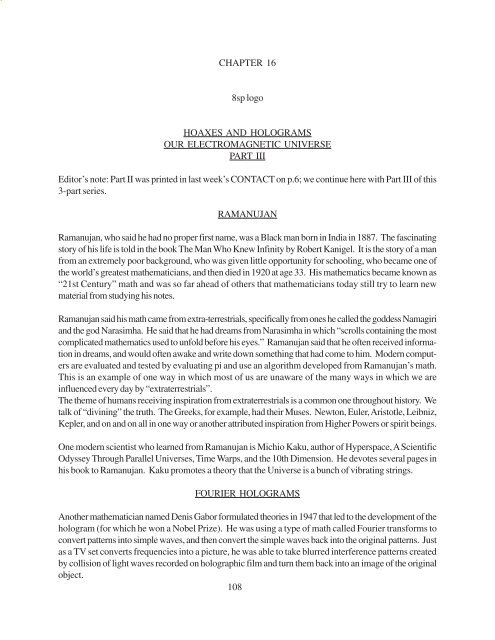Phoenix Journal 208 - Four Winds 10
Phoenix Journal 208 - Four Winds 10
Phoenix Journal 208 - Four Winds 10
You also want an ePaper? Increase the reach of your titles
YUMPU automatically turns print PDFs into web optimized ePapers that Google loves.
CHAPTER 16<br />
8sp logo<br />
HOAXES AND HOLOGRAMS<br />
OUR ELECTROMAGNETIC UNIVERSE<br />
PART III<br />
Editor’s note: Part II was printed in last week’s CONTACT on p.6; we continue here with Part III of this<br />
3-part series.<br />
RAMANUJAN<br />
Ramanujan, who said he had no proper first name, was a Black man born in India in 1887. The fascinating<br />
story of his life is told in the book The Man Who Knew Infinity by Robert Kanigel. It is the story of a man<br />
from an extremely poor background, who was given little opportunity for schooling, who became one of<br />
the world’s greatest mathematicians, and then died in 1920 at age 33. His mathematics became known as<br />
“21st Century” math and was so far ahead of others that mathematicians today still try to learn new<br />
material from studying his notes.<br />
Ramanujan said his math came from extra-terrestrials, specifically from ones he called the goddess Namagiri<br />
and the god Narasimha. He said that he had dreams from Narasimha in which “scrolls containing the most<br />
complicated mathematics used to unfold before his eyes.” Ramanujan said that he often received information<br />
in dreams, and would often awake and write down something that had come to him. Modern computers<br />
are evaluated and tested by evaluating pi and use an algorithm developed from Ramanujan’s math.<br />
This is an example of one way in which most of us are unaware of the many ways in which we are<br />
influenced every day by “extraterrestrials”.<br />
The theme of humans receiving inspiration from extraterrestrials is a common one throughout history. We<br />
talk of “divining” the truth. The Greeks, for example, had their Muses. Newton, Euler, Aristotle, Leibniz,<br />
Kepler, and on and on all in one way or another attributed inspiration from Higher Powers or spirit beings.<br />
One modern scientist who learned from Ramanujan is Michio Kaku, author of Hyperspace, A Scientific<br />
Odyssey Through Parallel Universes, Time Warps, and the <strong>10</strong>th Dimension. He devotes several pages in<br />
his book to Ramanujan. Kaku promotes a theory that the Universe is a bunch of vibrating strings.<br />
FOURIER HOLOGRAMS<br />
Another mathematician named Denis Gabor formulated theories in 1947 that led to the development of the<br />
hologram (for which he won a Nobel Prize). He was using a type of math called <strong>Four</strong>ier transforms to<br />
convert patterns into simple waves, and then convert the simple waves back into the original patterns. Just<br />
as a TV set converts frequencies into a picture, he was able to take blurred interference patterns created<br />
by collision of light waves recorded on holographic film and turn them back into an image of the original<br />
object.<br />
<strong>10</strong>8
















